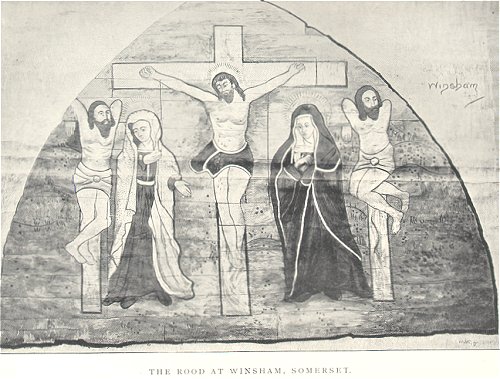The remarkable panel preserved in this church dates
from a period not long anterior to the Reformation. The detail in the
costume of the figures would indicate a date towards the close of the
fifteenth century. The original position of the panel was at one time a
subject of speculation, but comparison with other works of similar
character which have come to light leads to the conclusion that this was
without doubt the partition or 'Tympanum' which formerly
surmounted the Rood-screed and divided Nave from Sanctuary.
Until the restoration of the church in 1876, there
was a ringers' gallery under the tower, with a floor at or near the
level of the head of the screen, forming an unsightly obstruction in the
church. The painted panel was used as a back to this gallery,
and being disguised by accumulated coats of whitewash, the Vicar had it
removed with other obstructions.
But upon evidence of the existence of painting coming
to light, it was carefully preserved, and is now secured to the north
wall of the church under the tower, the screen being removed to the
eastward.
The panel has attracted the notice of local
antiquaries, and a drawing was made of it some years ago, which was
reproduced in Volume xxxvii of these Proceedings. More recently a fine
facsimile copy in colour has been executed for Mr. F. F. Fox, Past
President of the Gloucestershire Archaeological Society, who has devoted
a good deal of attention to the subject in his very valuable
Presidential Address on Roods and Rood-Lofts (Vol. xxiiii of their
Transactions); and a photographic copy was given, which, by Mr. Fox's
courtesy, I have the privilege of reproducing here. Readers are referred
to Mr. Fox's paper for the expert artist's opinion on the painting and
its condition.
 The Tympanum is the medieval substitute in the
Western Church for the Veil of the Sanctuary, which the primitive church
adopted from the Hebrew ritual. It has been shown by Bingham and others
that the tripartite division of the Temple was reproduced and
perpetuated in the Christian Church, and it is known that it persisted
in the west until a comparatively late date, whilst in the east it still
forms an important adjunct to the ritual of the Armenian and Ethiopian
churches.
The Tympanum is the medieval substitute in the
Western Church for the Veil of the Sanctuary, which the primitive church
adopted from the Hebrew ritual. It has been shown by Bingham and others
that the tripartite division of the Temple was reproduced and
perpetuated in the Christian Church, and it is known that it persisted
in the west until a comparatively late date, whilst in the east it still
forms an important adjunct to the ritual of the Armenian and Ethiopian
churches.
Durandus the monk, who wrote in the thirteenth
century, has recorded that the use was maintained in his day, and he
mentions that a veil or wall was the customary division, and this was
prescribed in an Anglo-Saxon Pontifical from which he quotes. Elsewhere
he alludes to a triple series of veils. St. Jerome is also recorded to
have commanded the use of veils.
The Anglo-Saxon Church always preserved very
scrupulously an effective division between nave and sanctuary, and in
some of our unspoilt early churches the solidity of the barrier is very
marked, the chancel opening being extremely narrow.
Several examples of these tympanums survive, bearing
ancient paintings. The Last Judgment is the subject usually represented,
and it would appear that the Crucifixion, as represented at Winsham, is
unusual. The west side of the screen was assigned to subjects of this
character for the following reason.
The screen was symbolic of Death, the barrier between
time and eternity, between the church militant and the church
triumphant. Thus the terrors of death to the impenitent, and the
consolations of the last hour of the just, were aptly exemplified by a
conspicuous rendering of the Doom in this position, and the Rood with
its attendant images crowning the screen, conveyed the teaching of the
divine conquest of death, and the intercessory powers of the saints.
On the east side of the tympanum the Resurrection was
appropriately depicted, and nothing of a grotesque or evil nature is
ever observed eastward of the screen. The Rood and attendant figures
surmounting the screen were generally carved, and were occasionally
attached to the painted panel behind them.
Perhaps Winsham and St. Albans are the only instances
which can be recorded of a painting of the Crucifixion upon the
tympanum, and the latter has unfortunately perished, with the exception
of the lower portion painted on panel-though a drawing is preserved in
the library of the Society of Antiquaries of London.